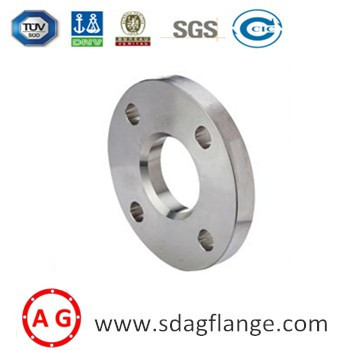Pipe Flanges: Essential Components for Secure and Leak-Free Connections
2025-03-07
When it comes to piping systems, ensuring the integrity and safety of connections is crucial. Whether it's in industrial, commercial, or residential applications, proper sealing and fastening of pipes are essential to prevent leaks, maintain pressure, and ensure smooth operation. One of the most reliable components for achieving these secure connections is the pipe flange.
In this blog, we will explore what pipe flanges are, the types available, their applications, and why they are vital for a variety of piping systems.
What is a Pipe Flange?
A pipe flange is a mechanical component used to connect two sections of pipe or to attach a pipe to other equipment, such as valves, pumps, or tanks. The flange provides a strong, secure connection by bolting the two flanged surfaces together, often with a gasket or sealing material in between to prevent leakage.
Pipe flanges come in various shapes and sizes, depending on the specific requirements of the application. They are commonly used in industries such as oil and gas, water treatment, chemical processing, and construction, where pressure and fluid flow need to be managed efficiently.
Key Features of Pipe Flanges
1. Material Variety
Pipe flanges are made from a range of materials to suit different environments and applications. The most common materials include:
- Carbon Steel: Used for general-purpose applications, offering strength and durability at a relatively low cost.
- Stainless Steel: Known for its corrosion resistance, stainless steel flanges are used in environments exposed to moisture, chemicals, or extreme temperatures.
- Alloy Steel: For applications that involve high-pressure and high-temperature conditions.
- Cast Iron and Ductile Iron: Often used in water and sewage applications, offering high strength at a reasonable cost.
Choosing the correct material ensures the flange can withstand the pressure, temperature, and corrosive elements of the environment.
2. Different Types of Flanges
There are several types of pipe flanges, each designed for specific applications. Here are some of the most common:
- Weld Neck Flange: These flanges have a long neck that allows for a strong, smooth weld to the pipe. They are typically used in high-pressure systems.
- Slip-On Flange: This type of flange slides over the pipe and is welded both inside and outside, making it ideal for applications where ease of installation is important.
- Blind Flange: Used to seal the end of a pipeline, a blind flange is essentially a solid disk that blocks off the flow in a piping system.
- Threaded Flange: This flange has internal threads that allow it to be screwed onto a pipe without the need for welding. It’s typically used in situations where welding is not feasible.
- Socket Weld Flange: These flanges are designed to fit over the pipe, with a socket that allows for a smooth weld. They are ideal for smaller diameter piping systems.
Each type of flange serves a specific purpose, and the choice depends on the application’s pressure, temperature, and the need for ease of assembly.
3. Pressure Ratings
Pipe flanges are rated for different pressure levels to ensure they can handle specific loads and conditions. These pressure ratings are typically designated as Class 150, Class 300, Class 600, and so on, with higher numbers corresponding to higher pressure resistance. This rating helps engineers determine which flanges are best suited for a particular application based on the operating pressure.
4. Sealing Function
To prevent leaks and ensure the integrity of the system, pipe flanges use a gasket or sealing material between the mating faces. Gaskets are typically made of materials like rubber, PTFE (polytetrafluoroethylene), or graphite, which can withstand the specific pressures and temperatures within the piping system.
Why Are Pipe Flanges Important?
1. Ensuring Leak-Free Connections
One of the most critical functions of pipe flanges is to create leak-proof connections in a piping system. When flanges are bolted together with the correct gasket or sealing material, they prevent any leakage of fluids or gases, which could otherwise lead to system failures, safety hazards, and environmental damage. The reliability of the connection depends on the material, the correct sealing, and proper installation.
2. Ease of Maintenance and Repair
Flanges allow for easier maintenance and repair of piping systems compared to welded connections. If a pipe section needs to be replaced or serviced, the flange connection can be easily unbolted, and the component can be removed or replaced. This ease of disassembly helps reduce downtime and lowers maintenance costs, making flanged connections an attractive choice for many industries.
3. Flexibility and Modularity
Flanges offer the flexibility to connect pipes of different sizes, materials, and orientations. This modularity allows for easy reconfiguration and expansion of piping systems. For example, if a piping system needs to be altered or expanded, new sections can be added using flanges, making it much easier than having to cut or weld pipes.
4. Handling High-Pressure Systems
In high-pressure environments, such as in oil and gas pipelines or chemical processing plants, the strength and durability of the flange connection are paramount. Flanges are designed to handle the extreme pressures of such systems, ensuring that they maintain integrity even under heavy loads. They also offer the flexibility to manage vibrations, thermal expansion, and contraction, all of which are common in high-pressure applications.
5. Customization for Specific Applications
Pipe flanges can be customized to suit specific needs, including material selection, size, and pressure rating. This customization ensures that the flange will meet the unique demands of any given system, whether it involves standard residential piping or complex industrial setups.
Applications of Pipe Flanges
Pipe flanges are used in a variety of industries and applications. Some common uses include:
- Oil and Gas: Flanges are widely used in offshore and onshore oil and gas exploration, transportation pipelines, and refining processes.
- Chemical and Pharmaceutical: In these industries, flanges help connect pipes that carry chemicals, gases, and other substances, ensuring safety and preventing leaks.
- Water Treatment: Flanged connections are used in water distribution systems, sewage treatment plants, and desalination facilities.
- Construction and HVAC: In construction, flanges are used to connect heating, ventilation, and air conditioning (HVAC) systems, as well as in fire protection systems and other building infrastructure.
Conclusion
Pipe flanges are essential components in modern piping systems, offering a reliable, flexible, and efficient way to connect pipes while ensuring the integrity and safety of fluid and gas transportation. With various types, materials, and pressure ratings available, there is a flange suitable for nearly every application, from residential plumbing to complex industrial systems. Whether you're an engineer, contractor, or DIY enthusiast, understanding pipe flanges is crucial to designing, maintaining, and troubleshooting piping systems effectively.



